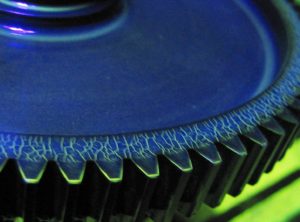Dan Reynolds, Technical Sales, is now a published author! The following article, written by Dan, appeared in the October 2013 issue of Cutting Tool Engineering and is used here with the permission of the publisher.
Nondestructive Testing Looks into Parts

This gear looks fine under normal lighting with the naked eye, but during a fluorescent magnetic particle inspection under black light, surface fractures are clearly visible. The cracks were probably caused by overheating during a grinding operation. These types of fractures can propagate into larger cracks, then part failure.
As the name implies, nondestructive testing, or inspection, of work pieces and parts doesn’t inflict harm. The four most common NDT methods are ultrasonic, magnetic particle, dye penetrant, and radiograph, or X-ray. NDT is usually a requirement when an unacceptable, or rejected, part could cause catastrophic failure and/or loss of human life. As a result, NDT is used extensively in the aerospace, military, power generation and medical industries.
Typically, NDT requirements are described on part drawings, using specifications with exact instructions that must be followed throughout the entire inspection process. After inspections are completed, parts are accepted or rejected based on the specification requirements and acceptance criteria.
NDT inspectors are generally certified by the company they work for and, in most cases, work under strict guidelines established by the American Society for Nondestructive Testing or National Aerospace Standards. Under these standards, inspectors using NDT must have hundreds or, sometimes, thousands of hours of hands-on experience and classroom training, including testing, to be certified. Most specifications require inspectors to be certified to one of these standards.
When repairing or rebuilding a machine tool, NDT can play a vital role. For example, a machine tool crash can have a ripple effect on various components, including drivelines, gears, splines and shafts. Even when a spindle isn’t running, a simple crash can cause extensive damage, most of which is visually obvious, but some of which is never seen without professional assistance.
For those rebuilding, reconditioning or retrofitting machine tools, think a step beyond any obvious visual damage. American Testing Services, Ltd. works with machine builders and rebuilders and performs regular inspections on gears, splines, centers and other components. Some of these parts are for new machines, while others are replacement parts or original parts being checked as per protocol during a rebuild. However, some rebuilders prefer not doing NDT because of the time and cost involved, forgetting about the insurance NDT provides.
Some surface defects, especially cracks or fractures that can’t be spotted with the naked eye, can be found with simple inspections that do not require extensive training to perform. This is the case whether it’s a crashed chuck jaw or tool-holder or internal gears and splines that were caught in the backlash. Nevertheless, checking part dimensions, straightness and flatness and visually inspecting everything may not be good enough.
NDT is one of the least-expensive forms of insurance in these situations. In rebuild cases, especially after a crash, impacted parts can have surface failures, such as cracks, splits, and tears, which are detectable via dye penetrant or magnetic particle inspection. If rebuilders prefer a DIY approach, they should contact a local welding supply house. Most of them carry an aerosol form of dye penetrant that can detect cracks the rebuilders wouldn’t otherwise be able to see. The instructions are pretty basic and are listed on the can, and all of the products needed for this simple inspection cost about $35.
If rebuilders prefer to have a professional inspection performed, they should call a local NDT lab, explain the situation and send pictures. The lab will advise them about the best inspection for the situation. In addition, most NDT labs offer on-site service for large parts needing inspection work.
NDT can also identify defects in new materials, which sometimes are not inspected. Ordering material with certifications doesn’t guarantee delivery of defect-free material. It’s wise to have the material inspected. Usually, the raw, premachined material can be checked internally using ultrasonic technology. When replacement or new parts are manufactured for high-speed machines operating under stress, heavy torque or extreme heat conditions, the material should be inspected before and after machining.
Most NDT labs operate like job shops, bidding on the inspection work. NDT is one of the last operations performed before a finished part is shipped, so most NDT shops can provide fast turnaround. Don’t be afraid to shop around for the best combination of price and service. Whether done inhouse or outsourced, NDT can be the perfect ounce of prevention that’s worth a pound – or even a ton – of cure.